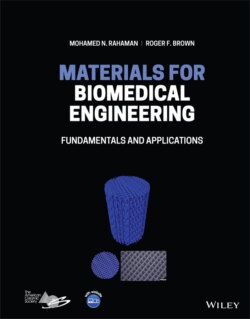Читать книгу Materials for Biomedical Engineering - Mohamed N. Rahaman - Страница 137
4.3.1 Effect of Porosity
ОглавлениеPorosity has a strong effect in reducing the elastic modulus (Figure 4.13) and the strength of materials. Introduction of porosity into metals and ceramics is a well‐known approach to bring their high strength and elastic modulus closer to those of bone. A variety of equations, theoretical and empirical, has been proposed to account for the effect of porosity on elastic modulus and strength. A popular equation based on a combination of simplicity and accuracy is
where, E is the Young’s modulus, Eo is the Young’s modulus at zero porosity, P is the porosity and b is parameter that depends on the shape and distribution of the pores in the material. Commonly, b is determined empirically from a fit of the experimental data for E versus P. For example, a good fit of Eq. (4.33) to the data shown in Figure 4.13 for a titanium alloy is obtained using Eo = 80 GPa and b = 4.7. Equation (4.33) often provides a good fit to data for P values up to ~25–40%. For higher porosity, one modification gives
where, b′ is a parameter determined from fitting the experimental data. Relationships similar in form to Eqs. (4.33) and (4.34) are often used to empirically describe the decrease in strength with porosity.
Figure 4.13 Data for the Young’s modulus as a function of porosity for a titanium specimen. The data points are fitted by a smooth curve.
